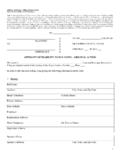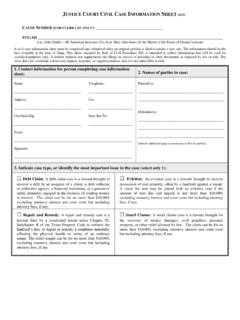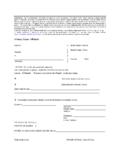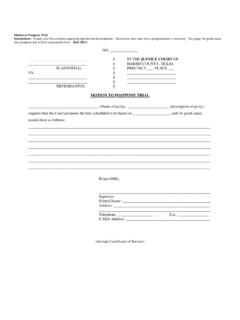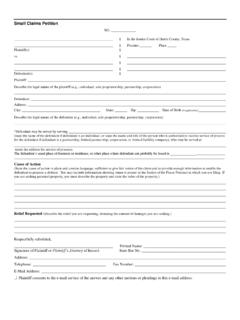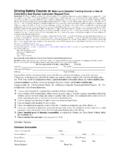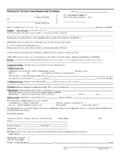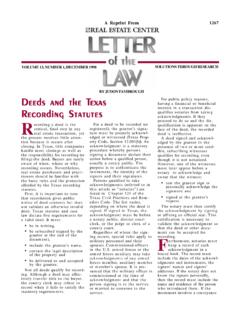Transcription of TEXAS RULES OF CIVIL PROCEDURE PART V - RULES OF …
1 Updated as of September 1, 2016 TEXAS RULES OF CIVIL PROCEDURE part V - RULES OF PRACTICE IN JUSTICE COURTS [ RULES 523 to 591. Repealed effective August 31, 2013] RULE 500. GENERAL RULES RULE CONSTRUCTION OF RULES Unless otherwise expressly provided, in part V of these RULES of CIVIL PROCEDURE : (a) the past, present, and future tense each includes the other; (b) the term it includes a person of either gender or an entity; and (c) the singular and plural each includes the other. RULE DEFINITIONS In part V of these RULES of CIVIL PROCEDURE : (a) Answer is the written response that a party who is sued must file with the court after being served with a citation. (b) Citation is the court-issued document required to be served upon a party to inform the party that it has been sued. (c) Claim is the legal theory and alleged facts that, if proven, entitle a party to relief against another party in court.
2 (d) Clerk is a person designated by the judge as a justice court clerk, or the judge if there is no clerk available. (e) Counterclaim is a claim brought by a party who has been sued against the party who filed the lawsuit, for example, a defendant suing a plaintiff. (f) County court is the county court, statutory county court, or district court in a particular county with jurisdiction over appeals of CIVIL cases from justice court. (g) Cross-claim is a claim brought by one party against another party on the same side of a lawsuit. For example, if a plaintiff sues two defendants, the defendants can seek relief against each other by means of a cross-claim. (h) Default judgment is a judgment awarded to a plaintiff when the defendant fails to answer and dispute the plaintiff s claims in the lawsuit. (i) Defendant is a party who is sued, including a plaintiff against whom a counterclaim is filed.
3 Updated as of September 1, 2016 (j) Defense is an assertion by a defendant that the plaintiff is not entitled to relief from the court. (k) Discovery is the process through which parties obtain information from each other in order to prepare for trial or enforce a judgment. The term does not refer to any information that a party is entitled to under applicable law. (l) Dismissed without prejudice means a case has been dismissed but has not been finally decided and may be refiled. (m) Dismissed with prejudice means a case has been dismissed and finally decided and may not be refiled. (n) Judge is a justice of the peace. (o) Judgment is a final order by the court that states the relief, if any, a party is entitled to or must provide. (p) Jurisdiction is the authority of the court to hear and decide a case.
4 (q) Motion is a request that the court make a specified ruling or order. (r) Notice is a document prepared and delivered by the court or a party stating that something is required of the party receiving the notice. (s) Party is a person or entity involved in the case that is either suing or being sued, including all plaintiffs, defendants, and third parties that have been joined in the case. (t) Petition is a formal written application stating a party s claims and requesting relief from the court. It is the first document filed with the court to begin a lawsuit. (u) Plaintiff is a party who sues, including a defendant who files a counterclaim. (v) Pleading is a written document filed by a party, including a petition and an answer, that states a claim or defense and outlines the relief sought. (w) Relief is the remedy a party requests from the court, such as the recovery of money or the return of property.
5 (x) Serve and service are delivery of citation as required by Rule , or of a document as required by Rule (y) Sworn means signed in front of someone authorized to take oaths, such as a notary, or signed under penalty of perjury. Filing a false sworn document can result in criminal prosecution. Updated as of September 1, 2016 (z) Third party claim is a claim brought by a party being sued against someone who is not yet a party to the case. RULE APPLICATION OF RULES IN JUSTICE COURT CASES (a) Small Claims Case. A small claims case is a lawsuit brought for the recovery of money damages, CIVIL penalties, personal property, or other relief allowed by law. The claim can be for no more than $10,000, excluding statutory interest and court costs but including attorney fees, if any. Small claims cases are governed by RULES 500-507 of part V of the RULES of CIVIL PROCEDURE .
6 (b) Debt Claim Case. A debt claim case is a lawsuit brought to recover a debt by an assignee of a claim, a debt collector or collection agency, a financial institution, or a person or entity primarily engaged in the business of lending money at interest. The claim can be for no more than $10,000, excluding statutory interest and court costs but including attorney fees, if any. Debt claim cases in justice court are governed by RULES 500-507 and 508 of part V of the RULES of CIVIL PROCEDURE . To the extent of any conflict between Rule 508 and the rest of part V, Rule 508 applies. (c) Repair and Remedy Case. A repair and remedy case is a lawsuit filed by a residential tenant under Chapter 92, Subchapter B of the TEXAS Property Code to enforce the landlord s duty to repair or remedy a condition materially affecting the physical health or safety of an ordinary tenant.
7 The relief sought can be for no more than $10,000, excluding statutory interest and court costs but including attorney fees, if any. Repair and remedy cases are governed by RULES 500-507 and 509 of part V of the RULES of CIVIL PROCEDURE . To the extent of any conflict between Rule 509 and the rest of part V, Rule 509 applies. (d) Eviction Case. An eviction case is a lawsuit brought to recover possession of real property under Chapter 24 of the TEXAS Property Code, often by a landlord against a tenant. A claim for rent may be joined with an eviction case if the amount of rent due and unpaid is not more than $10,000, excluding statutory interest and court costs but including attorney fees, if any. Eviction cases are governed by RULES 500-507 and 510 of part V of the RULES of CIVIL PROCEDURE . To the extent of any conflict between Rule 510 and the rest of part V, Rule 510 applies.
8 (e) Application of Other RULES . The other RULES of CIVIL PROCEDURE and the RULES of Evidence do not apply except: Updated as of September 1, 2016 (1) when the judge hearing the case determines that a particular rule must be followed to ensure that the proceedings are fair to all parties; or (2) when otherwise specifically provided by law or these RULES . (f) Examination of RULES . The court must make the RULES of CIVIL PROCEDURE and the RULES of Evidence available for examination, either in paper form or electronically, during the court s business hours. RULE REPRESENTATION IN JUSTICE COURT CASES (a) Representation of an Individual. An individual may: (1) represent himself or herself; (2) be represented by an authorized agent in an eviction case; or (3) be represented by an attorney. (b) Representation of a Corporation or Other Entity.
9 A corporation or other entity may: (1) be represented by an employee, owner, officer, or partner of the entity who is not an attorney; (2) be represented by a property manager or other authorized agent in an eviction case; or (3) be represented by an attorney. (c) Assisted Representation. The court may, for good cause, allow an individual representing himself or herself to be assisted in court by a family member or other individual who is not being compensated. RULE COMPUTATION OF TIME; TIMELY FILING (a) Computation of Time. To compute a time period in these RULES : (1) exclude the day of the event that triggers the period; (2) count every day, including Saturdays, Sundays, and legal holidays; and (3) include the last day of the period, but (A) if the last day is a Saturday, Sunday, or legal holiday, the time period is extended to the next day that is not a Saturday, Sunday, or legal holiday; and (B) if the last day for filing falls on a day during which the court is closed before 5:00 , the time period is extended to the court s next business day.
10 Updated as of September 1, 2016 (b) Timely Filing by Mail. Any document required to be filed by a given date is considered timely filed if deposited in the mail on or before that date, and received within 10 days of the due date. A legible postmark affixed by the United States Postal Service is evidence of the date of mailing. (c) Extensions. The judge may, for good cause shown, extend any time period under these RULES except those relating to new trial and appeal. RULE JUDGE TO DEVELOP THE CASE In order to develop the facts of the case, a judge may question a witness or party and may summon any person or party to appear as a witness when the judge considers it necessary to ensure a correct judgment and a speedy disposition. RULE EXCLUSION OF WITNESSES The court must, on a party s request, or may, on its own initiative, order witnesses excluded so that they cannot hear the testimony of other witnesses.
